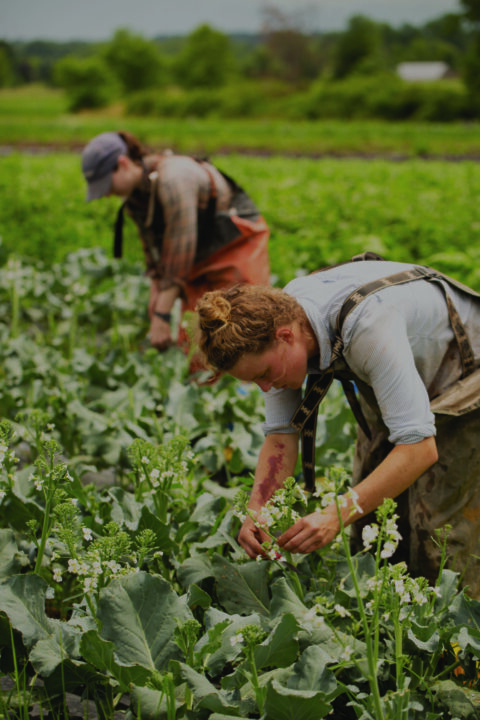
In the next two decades, it’s expected that nearly half of all farmland will transition hands as the aging farming population retires. This may be more of a challenge than expected: Nearly 60 percent of all young farmers are struggling to find available and affordable land to buy, and it’s even more difficult for farmers of color.
Why does that problem grab the attention of U.S. Energy Foundation (EF) and others who work to tackle the climate crisis? One reason is that, without long-term land access, farmers are unable to invest in regenerative agriculture, which uses practices that eliminate carbon in the soil over time.
When faced with a severe weather event, such as a wildfire or drought, farmers lose crops from damage or have to shut down their work. Eighty-three percent of young farmers say the primary purpose for their farms’ existence is to engage in conservation and regeneration, yet many are still unable to implement long-term practices that may mitigate the impacts of climate change. Sustainable practices, such as rotational grazing, low and no till, and biodynamic practices, are used by 97 percent of young farmers.
The National Young Farmers Coalition, an EF grantee, is an intersectional coalition working for justice and collective liberation of food and farm systems. They assist young farmers in overcoming the structural barriers put in their way from generations of inequity, including the lack of access to capital, healthcare costs, production costs, housing, and student loan debt.
“This next generation does not need to be convinced about climate change. They don’t need to be convinced to use climate-smart farming practices. They’re leading the charge,” said Aviva Paley, the Chief of Staff for Young Farmers. “But to ensure their success, we need to address the structural barriers that are preventing them from building a bright future in agriculture.”

To better understand what their members need, Young Farmers surveys farmers across the country every five years on their hopes, challenges, and needs to bring them success in their careers. For the past three survey cycles, “land access” has continued to be identified as the greatest challenge for all farmers.
In order to maintain a climate-smart farm, farmers must have long-term land access, and to have land access, farmers must become their own advocates. Young Farmers supports its members through training in advocacy.
“Young farmers are their best spokespeople,” said Paley. “We are training them on how to advocate and tell their story on the national stage so that our decision-makers can understand what their needs are and how to address them.”
Through the Coalition, young farmers learn about the policies that affect their work and engage in creative advocacy projects, such as writing op-eds for their local newspapers on their climate challenges or working on community organizing to implement climate resilient projects. Exercising the power their representation holds, there are now four young farmers sitting on their local water boards, responsible for making important decisions that affect local land use and farming practices.
In August 2022, their voices were heard. The U.S. Department of Agriculture (USDA) announced the Increasing Land, Capital, and Market Access Program, a $300 million grant program dedicated to assisting community-based organizations in acquiring capital for land access. The program funded 50 different projects, all with the goal of making land more accessible to underserved farmers. Some of these projects included purchasing and leasing land to tribal farmers, creating a pathway to land ownership for immigrants and refugees, and helping with housing for low-income farmers.
“It was in so many ways exactly what we had been fighting for,” said Paley. With the release of the grant program, the Young Farmers set out to help 19 organizations apply for funding by hiring grantwriters and guiding them through the application process. Ultimately, 13 of the organizations Young Farmers assisted were successfully granted funding. The program directly responded to the recommendations expressed by Young Farmers and the farmer leaders across their network, and reflected the innovative work that community-led organizations are already doing to address land-related challenges in their regions.
Looking forward, Young Farmers has created a strategic plan that will guide them through 2026. In addition to continuing their work to educate and inform farmers, the public, and decision-makers, they hope to see 500 Young Farmers serving in positions of leadership, whether that be on local water boards or national roles to make sure the future generation of farmers is heard and seen in these key areas.
“Dynamic networks working at the intersection of multiple issues and organizing empowered people to advocate for a just and clean future are so powerful and so important,” said Matthew Anderson, an EF Program Director for Midwest Campaigns. “Young Farmers is just such a network. And that’s why it is a privilege to support their work.”
 Story author Diana Gomez-Ochoa was a U.S. Energy Foundation intern in the summer of 2023.
Story author Diana Gomez-Ochoa was a U.S. Energy Foundation intern in the summer of 2023.

